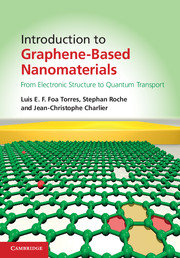Book contents
- Frontmatter
- Contents
- Preface
- 1 Introduction to carbon-based nanostructures
- 2 Electronic properties of carbon-based nanostructures
- 3 Quantum transport: general concepts
- 4 Klein tunneling and ballistic transport in graphene and related materials
- 5 Quantum transport in disordered graphene-based materials
- 6 Quantum transport beyond DC
- 7 Ab initio and multiscale quantum transport in graphene-based materials
- 8 Applications
- Appendix A Electronic structure calculations: the density functional theory (DFT)
- Appendix B Electronic structure calculations: the many-body perturbation theory (MBPT)
- Appendix C Green's functions and ab initio quantum transport in the Landauer–Büttiker formalism
- Appendix D Recursion methods for computing the DOS and wavepacket dynamics
- References
- Index
Appendix C - Green's functions and ab initio quantum transport in the Landauer–Büttiker formalism
Published online by Cambridge University Press: 05 February 2014
- Frontmatter
- Contents
- Preface
- 1 Introduction to carbon-based nanostructures
- 2 Electronic properties of carbon-based nanostructures
- 3 Quantum transport: general concepts
- 4 Klein tunneling and ballistic transport in graphene and related materials
- 5 Quantum transport in disordered graphene-based materials
- 6 Quantum transport beyond DC
- 7 Ab initio and multiscale quantum transport in graphene-based materials
- 8 Applications
- Appendix A Electronic structure calculations: the density functional theory (DFT)
- Appendix B Electronic structure calculations: the many-body perturbation theory (MBPT)
- Appendix C Green's functions and ab initio quantum transport in the Landauer–Büttiker formalism
- Appendix D Recursion methods for computing the DOS and wavepacket dynamics
- References
- Index
Summary
The Landauer-Büttiker (LB) formalism is widely used to simulate transport properties at equilibrium. The applications range from 1D conductors such as nanowires, nanotubes, nanoribbons, to 3D conductors such as molecular junctions with two or more contacts. At the ab initio level, this LB formalism is quite practical thanks to the Fisher–Lee relation, which connects the Landauer expression to the Green's function formalism. The transport properties of a given material can be simulated by finding the Green's function of the system within DFT (or even MBPT).
In this appendix the Green's function formalism is briefly reviewed. Section C.1 provides an introduction with a derivation of the trace formula starting from the Lippmann–Schwinger equations, then Section C.2 discusses recursive Green's function techniques, while Dyson's equation is introduced and applied to the case of a disordered system in Section C.3. Finally, Section C.4 is devoted to the implementation of LB formalism in conventional ab initio codes in order to investigate coherent electronic transport in nanoscale devices.
Phase-coherent quantum transport and the Green's function formalism
Green's functions are one of the most useful tools (Economou, 2006) for calculation of different physical quantities of interest such as the density of states or the quantum conductance and conductivity. In the context of phase-coherent quantum transport, they play a crucial role because their relation with the scattering matrix can be exploited to compute the quantum transmission probabilities as needed within the Landauer–Büttiker formalism presented in Section 3.3.
- Type
- Chapter
- Information
- Introduction to Graphene-Based NanomaterialsFrom Electronic Structure to Quantum Transport, pp. 338 - 357Publisher: Cambridge University PressPrint publication year: 2014



